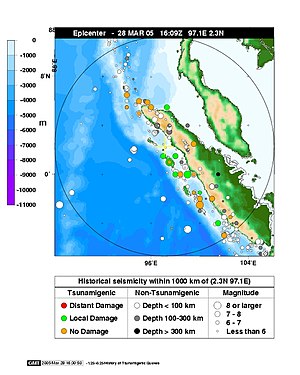Magnitude 8.7 earthquake hits Northern Sumatra, Indonesia

A magnitude 8.7 earthquake has been reported in northern Sumatra, Indonesia by the U.S. Geological Survey (originally an 8.2 magnitude at 2:37 ET (7:37 GMT) the USGS reclassified it to an 8.7 magnitude). Government spokesman Agus Mendrova reported more than 290 deaths on the island of Nias. Hundreds of others were reported trapped in collapsed buildings, including structures weakened by the December 26th earthquake.
A destructive wave was intially feared and many nations issued tsunami warnings. After the quake a USGS instrument near the Cocos Islands recorded a tsunami type wave which the USGS classified as "small." Tsunami warnings were later withdrawn.
The quake occurred at 11:09 ET (16:09 GMT), and is considered a "great" earthquake, the largest of seven grades. This earthquake is also classified as a "shallow" earthquake, occurring within the top 50 kilometres of the Earth's crust. Shallow earthquakes are more likely to cause a tsunami, because as the lower within the surface the earthquake occurs, the less warping of the ocean floor occurs. This earthquake was a thrust quake; the December 26th Indian Ocean quake was considered a megathrust quake.
The U.S. Geological Survey originally estimated the magnitude at 8.2, but Japan's Meteorological Agency measured the quake at magnitude 8.5 and the U.S. Geological Survey later raised its estimate to 8.7. In comparison, last December's earthquake was measured at 8.1 initially by the USGS, before finally being placed within the 9.1 to 9.3 range by scientists in February 2005.
At 16:29 UTC, an informational Tsunami Bulletin Number 001 was released by the Pacific Tsunami Warning Center, stating that there is no threat to Pacific coastlines, but warning of the possibility of destructive tsunamis on waters near the earthquake's origin.
There have been numerous reports of persons who have felt the earthquake fleeing their homes to higher ground, and Sri Lanka was under an evacuation order. Residents of Banda Aceh, Indonesia, one of the cities most devastated by the December tsunami, also fled. Since the December 26th earthquake relatively minor tremors have been common however this was reported to be more intense and long-lasting than any aftershock.
Thailand, which was criticized for its failure to alert citizens to tsunami dangers after last December's earthquake, warned about the possibility that a tsunami might hit that nation's southern provinces.
Sources
edit- "Magnitude 8.7 - NORTHERN SUMATRA, INDONESIA 2005 March 28 16:09:37 UTC" — U.S. Geological Survey, Monday, March 28, 2005 at 16:09:37 (UTC)
- "Big Earthquake Hits Off Indonesia Island" — Associated Press, Mon, Mar 28, 2005
- "TSUNAMI BULLETIN NUMBER 001" — PTWC, Monday, March 28, 2005 at 16:29 (UTC)
- "Quake strikes off Indonesia coast" — CNN, Monday, March 28, 2005 Posted: 12:15 PM EST (1715 GMT)
- "Information about Distant Earthquake" — Japan Meteorological Agency, March 28, 2005
- "Tsunamis feared as earthquake strikes off Sumatra" — Reuters, March 28, 2005
- "New quake makes only small waves (and other BBC stories)" — BBC News, 29 March, 2005, 12:38 GMT
See also
edit- "Aussie rescue chopper down: 9 dead" — Wikinews, April 3, 2005
- "Irish scientists had predicted further Sumatran earthquake" — Wikinews, March 29, 2005
- "Monday night's Indonesian quake toll appears less than first feared" — Wikinews, March 29, 2005
- "Foreign governments move to aid earthquake region" — Wikinews, March 28, 2005
- "Tsunami fears rise after latest Indonesian temblor" — Wikinews, March 28, 2005
- "2004 Indian Ocean Tsunami" — Wikinews, December 26, 2004 - January 6, 2005
- "Asian earthquake toll nears 60,000" — Wikinews, December 27, 2004